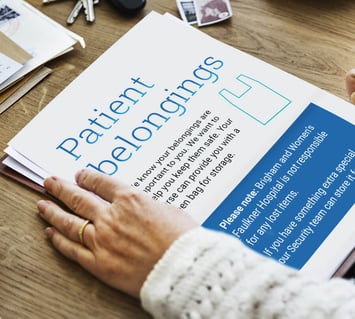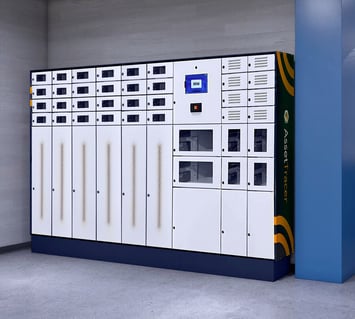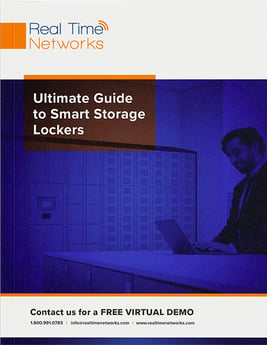By Jay Palter | November 16, 2022
The last thing you want your patients and their families worrying about is where they left their wallets, who has their important paperwork, or what happened to some especially cherished jewelry. But unfortunately, even when trips to healthcare centers are planned, families may not have adequately prepared for how to manage a patient’s belongings.
- Manual Patient Belonging Check-in/out Process is Error Prone
- The Cost of Patient Belongings Management is Hard to Quantify
- Lack of Data Surrounding Losses Makes Decision-making Difficult
- Analyze Your Existing Belongings Management Process
- Best Practices for Updating Your Patient Belongings Management
ER nurses often struggle to keep track of everything brought in with a patient by EMTs. And then ensure all of a patient’s belongings move with them between units or entire care centers.
If your center doesn’t adequately take care of patient belongings and valuables, you open yourself up to significant reimbursement costs, not to mention the work hours sunk into searching for valuables by both clinical and administrative staff. Worse still might be the unexpected costs that come with having a bad reputation for handling patient belongings.
That is why healthcare centers need reliable patient belonging management processes in place. So how do you improve belongings management, and what tools are available to help automate the process? This article answers those questions and more.
Manual Patient Belonging Check-in/out Process is Error Prone
Many healthcare centers rely on manual tracking processes for tracking patient belongings. For example, at check-in, a nurse will:
- Collect items from a patient
- Write down a list of those items on a paper form
- Deposit those items in a collection bag and attach the form to it
- Place the bag in a storage room or leave it in a patient’s closet
There are many potential failure points in that process. For example, a patient could forget to turn something over. A nurse could forget to write something down on the form. The patient belonging bag might get misplaced in the storage room or left in a patient’s closet when they change rooms. The list goes on.
The process also places the burden of protecting patient belongings entirely on clinicians or center administrative staff who might otherwise be available for more productive work.
The Cost of Patient Belongings Management is Hard to Quantify
We can break down the potential costs of losing patient belongings into direct and indirect cost categories.
Direct costs
Understandably, many hospitals don’t share loss figures externally. But from the available data, we can see that even small healthcare centers can expect to pay out five to six figures annually in patient reimbursements for lost valuables.
Indirect costs
There are also many indirect costs you need to consider. For example, direct cost figures don’t include nurse and staff time spent looking for missing valuables and managing the problem with the patient or their family. There is also the potential hit to your reputation if the patient decides to go public about when a hospital lost patient belongings, something Great Western Hospital in Swindon, England learned the hard way recently.
If a patient discovers they’ve lost valuables in your center, it can even impact their clinical recovery. Research from the American Society for Healthcare Risk Management (ASHRM) found that the “loss of essential items has been identified as a factor in worsening confusion, disorientation and nutritional status, which could lead to safety events such as falls and can be a barrier to comprehending discussions with providers.”
Lack of Data Surrounding Losses Makes Decision-making Difficult
Not only does this lack of data make it hard to assess what healthcare centers should include in their budgets for loss reimbursements, but it also makes decision-making about solving the problem of valuable loss incredibly challenging. For example, at what points are valuables most likely to go missing? Who is at fault, the nursing staff, the administrative staff, the patient, or their families?
Data collection is no easier when losses and reimbursements are handled individually by different clinic departments, security teams, and patient relations teams. As a result, it may be difficult or impossible to know your organization-wide expenditures today.
Analyze Your Existing Belongings Management Process
To improve patient belongings management, you must standardize and centralize the process. You want to take what typically is a complex, manual process with many moving parts and points for failure and turn it into a simple, organized, and, ideally, automated process that makes life easier for patients and healthcare staff.
Assemble stakeholders
To make changes, you first need to establish a baseline and fully understand how your center manages patient belongings loss across the entire organization. This will help you craft an effective solution and help you monitor any proposed changes as they’re rolled out across your organization.
Gather stakeholders from all impacted departments. Since the problem of patient belongings management is particularly far-reaching, this stakeholder group will likely be big. Consider whether in your organization it makes sense to include representatives from:
- Admitting clerks
- Emergency department
- In-patient departments
- Out-patient departments
- Security
- Facilities
- Risk management
Assess problem areas
You’re looking to assemble a team that can effectively identify problems in performance, share and evaluate potential solutions, and implement the chosen solution or solutions. Your goal is to understand and document how your organization handles patient valuables loss, and what works well and doesn’t.
Review your existing procedures in different departments. Also review how those issues are tracked, if at all. As you’re evaluating different units, try to collect reimbursement and other cost control figures to determine a tentative total direct cost figure for managing valuables loss. Lastly, review any existing loss prevention and management policies your organization already has.
Assess your data collection key capabilities
One specific area you need to assess is your ability to collect meaningful data about patient belongings in your possession. You're open to unnecessary risk if you don’t have a complete, real-time understanding of who has stored which belongings where. Therefore, you should assess your ability to track data at intake, on belongings in storage, and during each handoff—or transaction—within your process.
-
Tracking at intake
It all has to be accurate from the beginning, so your intake process must be simple for nursing staff who might need to log patient belongings in the middle of a stressful emergency room visit. First, gather all necessary information, such as patient ID, a list of all belongings, people authorized to access those belongings in the future, and their pending storage location.
-
Tracking in storage
This is sometimes called content surveillance. For example, for particularly high-value assets, you might want to log photos taken at the time of intake verifying the deposit. In exceptional circumstances, you can even add RFID tracking tags to storage bags, kits, or other high-value items, which an electronic storage system can track in real time. That will help keep employees accountable.
-
Tracking at handoff
In law enforcement, this is called chain of custody, a complete, uninterrupted record of who had possession of belongings at any given point in time. Every transaction people make with your storage system needs to make its way into your record, as those are the points at which errors are introduced into your management process.
Best Practices for Updating Your Patient Belongings Management
Once you have a solid understanding of the key problems you need to address and your existing data-gathering capabilities, it is time to have your stakeholders determine how to improve your patient belongings management. Here are some best practices most healthcare organizations will want to follow.
Deter patients from bringing valuables into your facility
Through whatever means possible, deter patients from bringing valuables into your center in the first place. This obviously isn’t an option in all situations, but for planned and routine visits, ask patients to leave valuables at home or with a caregiver.
Distribute notices to patients as part of their pre-visit instructions. Post notices at entrances. The fewer valuables for which your organization becomes responsible, the better.

Maintain a transparent policy
Consider drafting one if you don’t have a patient belongings policy. This policy should capture your personnel and patients' roles, responsibilities, and procedures they must follow. The ASHRM offers a template you can use to help draft a hospital patients belongings policy for your organization.
This policy should apply organization-wide. Remove the ability for individual departments or administrative teams to manage patient belongings in separate, undocumented ways. You want to remove as much variance in managing patient belongings as possible.

Use a storage system that supports data gathering
Whether you employ a manual or automated storage system, the process your personnel must follow needs to support effective data gathering of the three types identified above—tracking at intake, during storage, and at each handoff. Consider whether an electronic storage technology might be the right solution for your needs. These systems, sometimes called smart lockers, automate data gathering and manage transactions, so you minimize the chance for human error to disrupt your processes.
Smart patient belongings lockers are secure storage and distribution systems with a computer-controlled sensor network. They can track which valuables are available for sign-out by different patients, maintain detailed, real-time reports, and alert you to irregularities in sign-out patterns.


Learn more in our Ultimate Guide to Smart Lockers
Subscribe to our blog

Jay Palter
Vice President of Marketing & Partnerships




